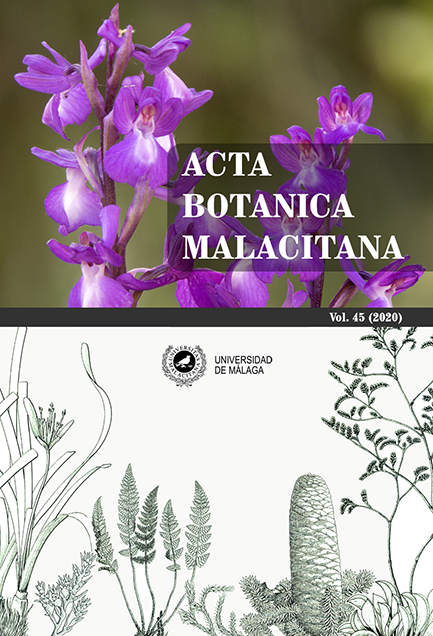Discovery of Ibicella lutea(Lindl.) Van Eselt. (Martyniaceae) in Kabylia (Béjaia, Algeria)
DOI:
https://doi.org/10.24310/abm.v45i.5186Keywords:
Ibicella lutea, discovery, Algeria, North AfricaAbstract
The author reports the discovery at Akbou (Bejaia, NE-Algeria) of yellow ibicella native from the semi-desert areas of South America.
Downloads
Metrics
References
Bolonio, D., Houachri, T., Llamas, A., Al-Lal, AM., Rodríguez-Ferna?ndez, J., El Gazza, M., Mittelbach, M., Lapuerta, M. & Canoira, L. (2017). Fatty acid methyl esters (FAMEs) obtained from rare seeds of Tunisia: Ibicella lutea, Peganum harmala, Smyrnium olusatrum, Onopordum nervosum and Solanum elaeagnifolium. Journal of Fundamentals of Renewable Energy and Applications, 7, 4 (Suppl). doi: 10.4172/2090-4541-C1-029
Bretting, P. K. (1984). Folk names and uses for martyniaceous plants. Economic Botany, 38, 452–463.
Cerdeiras, M.P., Fernández, J., Soubes, M., Vero, S., Ferreira, F., Moyna, P., Olano, L. & Vázquez, A. (2000). A new antibacterial compound from Ibicella lutea. Journal of Ethnopharmacology, 73 (3), 521-525. doi: 10.1016/S0378-8741(00)00339-1
DAISIE European Invasive Alien Species Gateway (2016). Ibicella lutea. Ville : éditeur (http://www.europe-aliens.org/speciesFactsheet.do?speciesId=19514#).
Debeaux, O.M. (1894). Flore de la Kabylie du Djurdjura, ou Catalogue méthodique et raisonné de toutes les plantes vasculaires et spontanées observées jusqu'à ce jour dans cette contrée. Paris : Librairie des Sciences Naturelles.
Dobignard, A. & Chatelain, C. (2010/2013). Index synonymique de la flore d’Afrique du Nord. Genève : éditeur.
El Mokni, R., Hamdi, N., De Belair, G. & Hédi El Aouni, M. (2012). Découverte d’Ibicella lutea (Lindl.) Van Eselt. (Martyniaceae) en Kroumirie (Nord-Ouest de la Tunisie). Poiretia, 4, 1-6.
Howell, J.T. (1933). Plants worthy of note – III. Leaflets of Western Botany, 1 (5), 39-40.
Le Bourgeois, T., Rodriguez, A., Vela, E., Marnotte, P. & Fried, G. (2017). Focus sur une espèce: Ibicella lutea (Lindl.) Van Eselt. Nouvelle observation d'une curieuse plante dans la Haute Garonne. Journal de Botanique, 79, 53-55.
Lousley, J.E. (1958). Alien plants introduced by the Yorkshire Wool Industry. The Naturalist, 866, 77-91.
Parsons, W.T. & Cuthbertson, E.G. (1992). Noxious weeds of Australia. Melbourne : Inkata Press.
Quézel, P. & Santa, S. (1962?1963). Nouvelle flore d’Algérie et des régions désertiques méridionales. Paris : CNRS.
Rice, B. (1999). Testing The Appetites of Ibicella and Drosophyllum. Carnivorous Plant Newsletter (CPN), 28(2), 40-43.
Rice, B. (2018). What are the genera Ibicella and Proboscidea like? The Carnivorous Plant FAQ v. 12 (http://www.sarracenia.com/faq/faq5720.html).
Riffle, M.S., Thilsted, W.E., Murray, D.S., Ahring, R.M. & Waller, G.R. (1988). Germination and seed production of unicorn-plant (Proboscidea louisianica). Weed Science, 36, 787-791.
Thellung, A. (1912). La flore adventice de Montpellier. Mémoire de la Société des Sciences Naturelles de Cherbourg, 38 : 57-728.
Shoar-Ghafari, A. & Vintéjoux, C. (2000). Morphologie des organes de capture des plantes carnivores. Acta Botanica Gallica, 147(1), 37-59. doi: 10.1080/12538078.2000.10515834
Sosa, V. & Zunino, P. (2009). Effect of Ibicella lutea on uropathogenic Proteus mirabilis growth, virulence, and biofilm formation. Journal of Infection in Developing Countries, 3(10), 762-770. doi: 10.3855/jidc.232
Tison, J.?M., Jauzein, P. & Michaud, H. (2014). Flore de France méditerranéenne continentale. Turriers : Naturalia Publications.
Verloove, F. (2006). Catalogue of neophytes in Belgium (1800-2005). Scripta Botanica Belgica, 39, 1- 89.
Downloads
Published
How to Cite
Issue
Section
License
Copyright (c) 2020 Acta Botanica Malacitana

This work is licensed under a Creative Commons Attribution-NonCommercial-ShareAlike 4.0 International License.
All information related to the licensing of published works in Acta Botanica Malacitana and copyright can be found in our Editorial Policy.







1.png)
